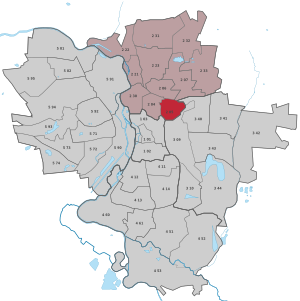At the water tower / Thaerviertel
|
At the water tower / Thaerviertel district of Halle |
|
|---|---|
| Coordinates | 51 ° 29 '34 " N , 11 ° 58' 54" E |
| Residents | 861 (Dec. 31, 2013) |
| Post Code | 06112, 06114 |
| prefix | 0345 |
| country | Saxony-Anhalt |
| Transport links | |
| Federal road |
|
| tram | 1 |
Am Wasserturm / Thaerviertel is a district of the Halle district in the northern district of the city of Halle (Saale) in Saxony-Anhalt , Germany
location
The district extends along the B6 and around the water tower north . It is bounded by Paracelsusstrasse, Berliner Chaussee, Liebigstrasse and Berliner Strasse.
Naming
The city quarter owes its name on the one hand to the 54 meter high water tower north built in 1898 and on the other hand to the Thaerviertel, a uniformly designed garden city settlement from the 1910s, which was named after Albrecht Daniel Thaer , the agricultural reformer and founder of agricultural science.
Area around the water tower
The water tower is one of the urban landmarks of Halle in the middle of the traffic and open spaces of Rossplatz. Wilhelminian style and Art Nouveau houses form part of the western development on Paracelsusstrasse. The buildings of the former barracks on the eastern side of the street, built in 1891/1892, were partly renovated and partly demolished. The new Halle branch of the Deutsche Rentenversicherung Mitteldeutschland was built on the site . The area of the University Clinic and Polyclinic for Psychiatry, Psychotherapy and Psychosomatics on Julius-Kühn-Strasse and the large green area of the Nordfriedhof are also characteristic of the district .
Thaerviertel
Today's Thaerviertel was designed by Hermann Frede as a “garden city on the Mühlrain”, based on models from southern German reform architecture in 1913 and implemented in practice by 1919. Despite the outbreak of war, the first houses could already be occupied on October 1, 1914. Further construction phases followed during the war years. After its completion, the residential complex, which was designed as a heavily greened settlement, consisted of 92 one to three-storey plastered buildings with high mansard and gable roofs, dwarf houses and loggias. The closed character of the architecturally remarkable settlement has been preserved to this day, despite some architectural and decorative losses.
Neighboring districts
Neighboring districts are:
- Paulusviertel in the west
- Territory of the DR in the east and south
- Landrain and a happy future in the north
literature
- Jens Lipsdorf : Hermann Frede. An architect from Halle between tradition and modernity 1883-1965. Friends of the Buildings and Art Monuments of Saxony-Anhalt eV, Halle (Saale) 1998. pp. 22–28.
- Holger Brülls, Thomas Dietsch: Architectural Guide Halle on the Saale . Dietrich Reimer Verlag, Berlin, 2000, ISBN 3496012021 . P. 99.
Web links
- Halle (Saale) in figures (PDF; 309 kB)
- City of Halle: City district Am Wasserturm / Thaerviertel
- Mitteldeutsche Zeitung on the Am Wasserturm / Thaerviertel district, August 27, 2003
Individual evidence





